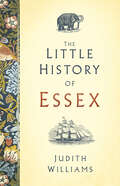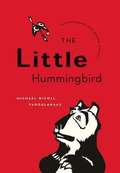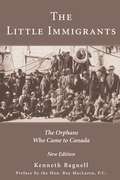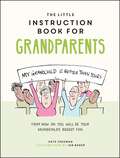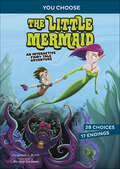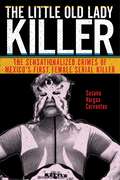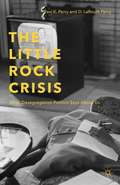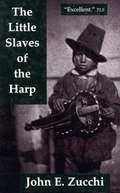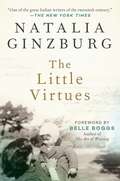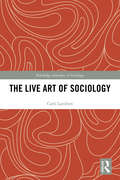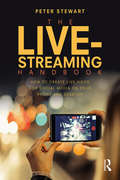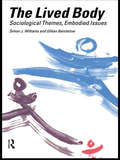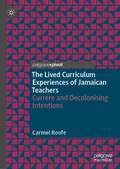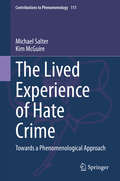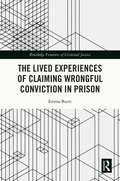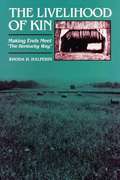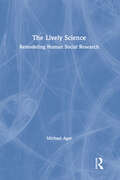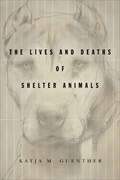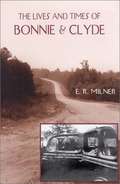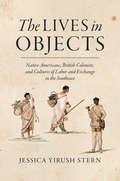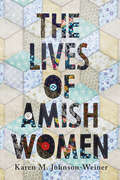- Table View
- List View
The Little History of Essex
by Judith WilliamsThere is nothing ‘little’ about the history of Essex! However, this small volume condenses that fascinating, rich history into a collection of stories and facts that will make you marvel at the events our county has witnessed. Discover the development of ship building at Harwich, the silk and woollen industries in central Essex, the fortunes of Chelmsford and Colchester and the rise of seaside resorts at Southend and Clacton. Take a journey through Essex’s historic struggles and celebrations or jump in to the era of your choice to discover the who, what and why of our county’s history.
The Little Hummingbird
by Michael Nicoll YahgulanaasThis children's book is based on a South American indigenous story about a courageous hummingbird who defies fear and expectations in her attempt to save the forest from fire. The story is supplemented by a natural and cultural history of hummingbirds, as well as an inspiring message. The Artist complements this optimistic tale that encourages everyone to take responsibility for their home and the planet.
The Little Ice Age: How Climate Made History 1300-1850
by Brian FaganOnly in the last decade have climatologists developed an accurate picture of yearly climate conditions in historical times. This development confirmed a long-standing suspicion: that the world endured a 500-year cold snap-The Little Ice Age-that lasted roughly from A.D. 1300 until 1850. The Little Ice Age tells the story of the turbulent, unpredictable and often very cold years of modern European history, how climate altered historical events, and what they mean in the context of today's global warming. With its basis in cutting-edge science, The Little Ice Age offers a new perspective on familiar events. Renowned archaeologist Brian Fagan shows how the increasing cold affected Norse exploration; how changing sea temperatures caused English and Basque fishermen to follow vast shoals of cod all the way to the New World; how a generations-long subsistence crisis in France contributed to social disintegration and ultimately revolution; and how English efforts to improve farm productivity in the face of a deteriorating climate helped pave the way for the Industrial Revolution and hence for global warming. This is a fascinating, original book for anyone interested in history, climate, or the new subject of how they interact.
The Little Immigrants: The Orphans Who Came to Canada
by Kenneth BagnellThe Little Immigrants is a tale of compassion and courage and a vivid account of a deep and moving part of Canadian heritage. In the early years after Confederation, the rising nation needed workers that could take advantage of the abundant resources. Until the time of the Depression, 100,000 impoverished children from the British Isles were sent overseas by well-meaning philanthropists to solve the colony’s farm-labour shortage. They were known as the "home children," and they were lonely and frightened youngsters to whom a new life in Canada meant only hardship and abuse. This is an extraordinary but almost forgotten odyssey that the Calgary Herald has called, "One of the finest pieces of Canadian social history ever to be written." Kenneth Bagnell tells "an affecting tale of Dickensian pathos" (Vancouver Sun) that is "excellent … well organized, logical, clearly written, [and] suspenseful" (The Edmonton Journal).
The Little Instruction Book for Grandparents: Tongue-in-Cheek Advice for Surviving Grandparenthood
by Kate FreemanSo you’re a grandparent! One of the most magical roles you’ll ever have – but also one of the messiest. But never fear: this indispensable handbook is here to guide you through the pleasures and pitfalls of grandparenthood, and, most importantly, teach you how to keep the grandkids quiet while you catch up on your nap-time.
The Little Instruction Book for Grandparents: Tongue-in-Cheek Advice for Surviving Grandparenthood
by Kate FreemanSo you’re a grandparent! One of the most magical roles you’ll ever have – but also one of the messiest. But never fear: this indispensable handbook is here to guide you through the pleasures and pitfalls of grandparenthood, and, most importantly, teach you how to keep the grandkids quiet while you catch up on your nap-time.
The Little Mermaid: An Interactive Fairy Tale Adventure (You Choose)
by Eric BraunYou've heard the tale of the little mermaid. But did you know that the mermaid was really a rock star? Or that the prince was burping under the sea? Be part of that world as you swim your way through three twisted takes on the classic fairy tale. Will YOU CHOOSE the path to your happily ever after?
The Little Old Lady Killer: The Sensationalized Crimes of Mexico's First Female Serial Killer (Alternative Criminology #20)
by Susana Vargas CervantesThe surprising true story of Mexico’s hunt, arrest, and conviction of its first female serial killerFor three years, amid widespread public outrage, police in Mexico City struggled to uncover the identity of the killer responsible for the ghastly deaths of forty elderly women, many of whom had been strangled in their homes with a stethoscope by someone posing as a government nurse. When Juana Barraza Samperio, a female professional wrestler known as la Dama del Silencio (the Lady of Silence), was arrested—and eventually sentenced to 759 years in prison—for her crimes as the Mataviejitas (the little old lady killer), her case disrupted traditional narratives about gender, criminality, and victimhood in the popular and criminological imagination.Marshaling ten years of research, and one of the only interviews that Juana Barraza Samperio has given while in prison, Susana Vargas Cervantes deconstructs this uniquely provocative story. She focuses, in particular, on the complex, gendered aspects of the case, asking: Who is a killer? Barraza—with her “manly” features and strength, her career as a masked wrestler in lucha libre, and her violent crimes—is presented, here, as a study in gender deviance, a disruption of what scholars call mexicanidad, or the masculine notion of what it means to be Mexican. Cervantes also challenges our conception of victimhood—specifically, who “counts” as a victim.The Little Old Lady Killer presents a fascinating analysis of what serial killing—often considered “killing for the pleasure of killing”—represents to us.
The Little Rock Crisis
by Ravi K. Perry D. Larouth PerryThe Little Rock Crisis describes the power of direct and learned memories of the 1957 desegregation crisis in Little Rock, Arkansas. Personal, dramatic experiences of Little Rockians – known and unknown – reflect on the impact of the crisis on their lives in the 21st century. Linking individual memories to collective action through the lens of social appropriation, the book explores how the crisis has impacted the political behavior of Little Rockians. Oral histories and surveyresearch show how the events from the tumultuous 1950s in Little Rock school politics, inform and direct the national political engagement and local community involvement of diverse residents.
The Little Slaves of the Harp: Italian Child Street Musicians in Nineteenth-Century Paris, London, and New York (McGill-Queen's Studies in Ethnic History #13)
by John E. ZucchiDuring the nineteenth century child musicians could be seen performing in the streets of cities across Europe and North America. Although they came from a number of countries, Italians were most associated with street music. In The Little Slaves of the Harp John Zucchi tells the story of the thousands of Italian children who were indentured to padrone and then uprooted from their villages in central and southern Italy and taken to Paris, London, and New York to perform as barrel-organists, harpists, violinists, fifers, pipers, and animal exhibitors.
The Little Third Reich on Lake Superior: A History of Canadian Internment Camp R
by Ernest Robert ZimmermannAn in-depth history of one of Canada’s World War II internment camps that held both Nazis and anti-Nazis alike.For eighteen months during the Second World War, the Canadian military interned 1,145 prisoners of war in Red Rock, Ontario (about 100 kilometres northeast of Thunder Bay). Camp R interned friend and foe alike: Nazis, anti-Nazis, Jews, soldiers, merchant seamen, and refugees whom Britain feared might comprise Hitler’s rumoured “fifth column” of alien enemies residing within the Commonwealth. For the first time and in riveting detail, the author illuminates the conditions in one of Canada’s forgotten POW camps. Backed by interviews and meticulous archival research, Zimmermann fleshes out this rich history in an accessible, lively manner. The Little Third Reich on Lake Superior will captivate military and political historians as well as non-specialists interested in the history of POWs and internment in Canada.“Most of us have an image of what prisoner of war camps looked like, either from documentary footage about Nazi POW camps, or feature films about World War II, or television situation comedies. The Little Third Reich on Lake Superior shatters all of those stereotypes and, through diligent assembly of public records, multiple library archives and personal interviews, gives us an in-depth picture of a Canadian internment camp. All of this is skillfully organized in a reader-friendly, chronological way.” —Michael Sabota, Chronicle Journal“The study shines light on the lesser-known Canadian prisoner of war (POW) camps in World War II. In this well-researched study, Zimmermann describes not only Camp R, but the inmates, guards, military command structure, politicians, and general political environment in Canada and Britain. . . . The work is easy to read and deftly supported by a broad array of sources. Zimmermann’s analysis encompasses Canadian and British history. . . . The Little Third Reich on Lake Superior sets a high standard for future research into civilian internment camps.” —Anna Marie Anderson, The Journal of Military History
The Little Virtues: Essays
by Natalia Ginzburg Belle BoggsIn this collection of her finest and best-known short essays, Natalia Ginzburg explores both the mundane details and inescapable catastrophes of personal life with the grace and wit that have assured her rightful place in the pantheon of classic mid-century authors. Whether she writes of the loss of a friend, Cesare Pavese; or what is inexpugnable of World War II; or the Abruzzi, where she and her first husband lived in forced residence under Fascist rule; or the importance of silence in our society; or her vocation as a writer; or even a pair of worn-out shoes, Ginzburg brings to her reflections the wisdom of a survivor and the spare, wry, and poetically resonant style her readers have come to recognize. "A glowing light of modern Italian literature . . . Ginzburg's magic is the utter simplicity of her prose, suddenly illuminated by one word that makes a lightning streak of a plain phrase. . . . As direct and clean as if it were carved in stone, it yet speaks thoughts of the heart.' — The New York Times Book Review
The Live Art of Sociology (Routledge Advances in Sociology)
by Cath LambertThe Live Art of Sociology attends to the importance of ‘the live’ in contemporary social and political life. Taking existing work in live sociology as a starting point, this book considers some of its aspirations through unique empirical investigations. Queer and feminist theory and methods are also employed in exploring the challenges of researching live experiences and temporalities. With case study examples ranging from the work of live body artists to experiments in curating sociological research, Lambert successfully demonstrates the diverse ways in which art can provide the aesthetic and affective conditions for social and political disruption. By emphasising the political importance of how people, knowledges, materials, emotions and senses are configured and reconfigured, The Live Art of Sociology asserts a creative and vital role for sociology in not only representing but also generating social realities and political possibilities. Putting aesthetics at the heart of contemporary sociology and making a strong case for a renewed sociological aesthetics, this volume will appeal to undergraduate and postgraduate students as well as postdoctoral researchers and academics interested in fields such as Sociology, Cultural Studies, Art and Visual Culture, Gender and Sexuality Studies and Leisure Studies. It will also be of interest to creative practitioners.
The Live-Streaming Handbook: How to create live video for social media on your phone and desktop
by Peter StewartThe Live-Streaming Handbook will teach you how to present live-video shows from your phone and stream them straight to Facebook and Twitter. With this book and your favourite social media apps, you will be able to run your own TV station for your home or work. Peter Stewart, an experienced TV and radio presenter, producer and author, now shares the training he’s given to professional broadcasters with you! From structuring and developing a show, to establishing an effective online persona and getting more people to watch you. The book includes dozens of tried and tested formats for your live-video show, alongside case studies highlighting how businesses and professionals are using live-streaming in their brand and marketing strategies. Also included are: a foreword by Al Roker (NBC's The Today Show); practical steps for using popular live-streaming apps, such as Facebook Live and Twitter; nearly 80 colour images of live-streaming events, screenshots and gadgets; a detailed walk-through of how to successfully present and produce your live-streaming show; advice on analysing and exploiting viewer metrics to increase followers; more than 130 quotes of real-world advice from expert producers of online media content; over 700 links to online case studies, articles, research and background reading. With this extensive manual you will gain a competitive edge in the world of online live-streaming. This book is invaluable to entrepreneurs, professionals and students working in journalism, public relations, marketing and digital media, as well as general readers interested in live-streaming at home.
The Lived Body: Sociological Themes, Embodied Issues
by Simon J. Williams Gillian A. BendelowThe Lived Body takes a fresh look at the notion of human embodiment and provides an ideal textbook for undergraduates on the growing number of courses on the sociology of the body.The authors propose a new approach - an 'Embodied Sociology' - one which makes embodiment central rather than peripheral. They critically examine the dualist legacies of the past, assessing the ideas of a range of key thinkers, from Marx to Freud, Foucault to Giddens, Deleuze to Guattari and Irigary to Grosz, in terms of the bodily themes and issues they address.They also explore new areas of research, including the 'fate' of embodiment in late modernity, sex, gender, medical technology and the body, the sociology of emotions, pain, sleep and artistic representations of the body.The Lived Body will provide students and researchers in medical sociology, health sciences, cultural studies and philosophy with clear, accessible coverage of the major theories and debates in the sociology of the body and a challenging new way of thinking.
The Lived Curriculum Experiences of Jamaican Teachers: Currere and Decolonising Intentions
by Carmel RoofeThis book offers first-person narratives of teachers’ curriculum encounters. The reflections of teachers are presented using Pinar’s Method of Currere as a tool for undertaking deep analysis of teachers’ curriculum encounters. The Method of Currere allows teachers to embody curriculum in all its forms, allowing for reflection on encounters in the formal, informal, hidden curriculum and beyond. The book aims to provide readers with a broad understanding of curriculum as the lived experience encapsulating the educational, personal, and professional life of the teacher. In this way teachers are able to trace and make sense of the development of their knowledge and make changes that lead to the continuous offering of quality education. The book will be of interest to students, scholars and practitioners involved in curriculum studies, teacher education/training, teaching, and general education.
The Lived Experience of Hate Crime: Towards a Phenomenological Approach (Contributions to Phenomenology #111)
by Michael Salter Kim McGuireThis book approaches the topic of the subjective, lived experience of hate crime from the perspective of Husserlian phenomenology. It provides an experientially well-grounded account of how and what is experienced as a hate crime, and what this reveals about ourselves as the continually reconstituted “subject” of such experiences. The book shows how qualitative social science methods can be better grounded in philosophically informed theory and methodological practices to add greater depth and explanatory power to experiential approaches to social sciences topics. The Authors also highlight several gaps and contradictions within Husserlian analyses of prejudice, which are exposed by attempts to concretely apply this approach to the field of hate crimes.Coverage includes the difficulties in providing an empathetic understanding of expressions of harmful forms of prejudice underlying hate crimes, including hate speech, arising from our own and others’ ‘life worlds’. The Authors describe a ‘Husserlian-based’ view of hate crime as well as a novel interpretation of the value of the comprehensive methodological stages pioneered by Husserl. The intended readership includes those concerned with discrimination and hate crime, as well as those involved in qualitative research into social topics in general. The broader content level makes this work suitable for undergraduate and postgraduate students, even professionals within law enforcement.
The Lived Experiences of Claiming Wrongful Conviction in Prison (Routledge Frontiers of Criminal Justice)
by Emma BurttThe Lived Experiences of Claiming Wrongful Conviction in Prison focuses on the lived experience of maintaining innocence in the prison environment and highlights the struggles and pain that such a claim can cause. Using the little utilised means of conducting an interview via a series of letters, the book details the experiences of 64 prisoners maintaining innocence in England and Wales, and examines in depth what is unique to this population. The chapters cover coping mechanisms, relationships maintained with relatives, relationships formed with prisoners and staff, and the perceived effect of their claims on matters of progression and parole. It draws on material from criminology, sociology, law, and psychology to provide a holistic account of this population’s experiences. The Lived Experiences of Claiming Wrongful Conviction in Prison will be of great interest to students and scholars across the disciplines of criminology, criminal justice, law, sociology, and psychology.
The Lived Experiences of Muslims in Europe: Recognition, Power and Intersubjective Dilemmas (Routledge Studies in Social and Political Thought)
by Des DelaneyThis book unearths new knowledge and challenges existing paradigms in relation to the integration of minority communities. It comprehensively reflects upon the complexity of recognition experiences and integration challenges faced by Muslim individuals and groups in Europe. By focusing on universal recognition themes related to experiences within personal relationships, legal relations, religion and civil society, it makes an essential contribution to a deeper understanding of Muslim life in the West.It offers a reconsideration of everyday lives of Muslims in Europe by drawing on the paradigm of recognition. Exploring universal themes, it demonstrates the complexity of recognitive relations by examining how Muslim individuals perceive the ways they are recognised, or misrecognised, within various spheres of everyday interaction. It sheds light on the ways in which forms of recognition affect identity formation and social relations more generally, and the broader ramifications that arise from such forms of misrecognition. This book draws on Honneth’s critical social theory of recognition to frame a range of grassroots interviews and focused discussion groups. Grounded in qualitative research and with an emancipatory intent, The Lived Experiences of Muslims in Europe challenges both the assumption that minority groups simply seek to have their particular culture and associated beliefs endorsed by a majority, and the security paradigm that narrowly views Muslims in Europe through the lens of political extremism.
The Livelihood of Kin: Making Ends Meet "The Kentucky Way"
by Rhoda HalperinRural Appalachians in Kentucky call it "The Kentucky Way"-making a living by doing many kinds of paid and unpaid work and sharing their resources within extended family networks. In fact, these strategies are practiced by rural peoplein many parts of the world, but they have not been studied extensively in the United States. In The Livelihood of Kin, Rhoda Halperin undertakes a detailed exploration of this complex, family-oriented economy, showing how it promotes economic well-being and a sense of identity for the people who follow it. Using actual life and work histories, Halperin shows how people make a living "in between" the cash economy of the city and the agricultural subsistence economy of the country. In regionally based, three-generation kin networks, family members work individually and jointly at many tasks: small-scale agricultural production, food processing and storage, odd jobs, selling used and new goods in marketplaces, and wage labor, much of which is temporary. People can make ends meet even in the face of job layoffs and declining crop subsidies. With these strategies people win a considerable degree of autonomy and control over their lives. Halperin also examines how such multiple livelihood strategies define individual identity by emphasizing a person's role in the family network over an occupation. She reveals, through psychiatric case histories, what damage can result when individuals leave the family network for wage employment in thecities, as increasing urbanization has forced many people to do. While certainly of interest to scholars of Appalachian studies, this lively and readable study will also be important for economic anthropologists and urban and rural sociologists.
The Lively Science: Remodeling Human Social Research
by Michael AgarThe Lively Science is Michael Agar's accessible, idiosyncratic, often humorous, and sometimes controversial explication of his own polestar truth: "Research on humans in their social world by other humans is not a traditional science like the one created by Galileo and Newton." However, if the social world is not a lab, neither is it a collection of random events. The book lays out a clear, straightforward path to carrying out the basic scientific tasks of forming questions and answering them to explore and account for that non-randomness. The author deploys myriad engaging examples drawn from a lifetime of applied and basic research to demonstrate how human science researchers can produce discoveries that are scientifically defensible and useful in the real world. Agar grounds his how-to guide in an approachable discussion of epistemology and draws on thinkers whose writings may be unfamiliar to many social scientists. He blends that work with new intellectual tools, such as complexity theory, disasters research, and conversational analysis. The result is an innovative and practical methodology that is true to the realities and surprises of research by and about humans, yet preserves scientific standards of falsifiability, empiricism, logic, and systematic presentation of results. This book represents the best of Michael Agar's visionary work. With a new foreword by Michael Brown celebrating Agar's enormous contribution to social science methodology, The Lively Science is for all researchers who seek to explore the full potential of a human social science.
The Lives and Deaths of Shelter Animals: The Lives and Deaths of Shelter Animals
by Katja M. GuentherMonster is an adult pit bull, muscular and grey, who is impounded in a large animal shelter in Los Angeles. Like many other dogs at the shelter, Monster is associated with marginalized humans and assumed to embody certain behaviors because of his breed. And like approximately one million shelter animals each year, Monster will be killed. The Lives and Deaths of Shelter Animals takes us inside one of the country's highest-intake animal shelters. Katja M. Guenther witnesses the dramatic variance in the narratives assigned different animals, including Monster, which dictate their chances for survival. She argues that these inequalities are powerfully linked to human ideas about race, class, gender, ability, and species. Guenther deftly explores internal hierarchies, breed discrimination, and importantly, instances of resistance and agency.
The Lives and Times of Bonnie and Clyde
by E. R. MilnerFrom the Book Jacket: Relying on primary sources-oral history interviews, personal memoirs, newspaper articles, official records, diaries, and letters-E. R. Milner cuts through myth and legend to create this startling portrait of the real Bonnie and Clyde. In his prologue, Milner introduces Bonnie Parker and Clyde Barrow, showing them as they drive along a rural Louisiana lane toward the ambush that would put a dramatic end to their turbulent lives of crime. Milner then traces their backgrounds, noting the events that bring the two outlaws together. The ensuing adventures of Bonnie and Clyde featured gun battles, narrow escapes and captures, frequent moves, and, of necessity, several shifts in personnel over a short period of time. It was a life of wild action, betrayal, and sometimes even gallantry. In the abstract, an aura of romance surrounded this violent pair. Although the mythology surrounding Bonnie and Clyde is charged with drama and fascination, Milner reveals the truth behind the bloody legend, carefully gleaning materials from obscure locally published accounts, previously untapped court records, and archived but unpublished oral history accounts from some sixty victims, neighbors, relatives, and police who were involved in the exploits of the infamous duo. And the truth proves to be sufficiently exciting. Romance aside, the Barrow gang carved a grisly swath through Texas, Arkansas, Oklahoma, and Missouri. The string of deaths was long-and real: Akota, Oklahoma, sheriff severely wounded, deputy killed; Sherman, Texas, grocery clerk killed; Temple, Texas, man killed as gang attempts to steal his car; Joplin, Missouri, two officers killed; Alma, Arkansas, police officer killed; Crockette, Texas, prison guard killed; Miami, Oklahoma, police officer killed. Milner traces this violent path until 23 May 1934, when Bonnie and Clyde die in an ambush. Even dead, they draw crowds and are buried in a circus-like atmosphere. In death they continue to intrigue us in ways few criminals had before or have since. E. R. Milner is a professor of history and government at Tarrant College.
The Lives in Objects: Native Americans, British Colonists, and Cultures of Labor and Exchange in the Southeast
by Jessica Yirush SternIn The Lives in Objects, Jessica Yirush Stern presents a thoroughly researched and engaging study of the deerskin trade in the colonial Southeast, equally attentive to British American and Southeastern Indian cultures of production, distribution, and consumption. Stern upends the long-standing assertion that Native Americans were solely gift givers and the British were modern commercial capitalists. This traditional interpretation casts Native Americans as victims drawn into and made dependent on a transatlantic marketplace. Stern complicates that picture by showing how both the Southeastern Indian and British American actors mixed gift giving and commodity exchange in the deerskin trade, such that Southeastern Indians retained much greater agency as producers and consumers than the standard narrative allows. By tracking the debates about Indian trade regulation, Stern also reveals that the British were often not willing to embrace modern free market values. While she sheds new light on broader issues in native and colonial history, Stern also demonstrates that concepts of labor, commerce, and material culture were inextricably intertwined to present a fresh perspective on trade in the colonial Southeast.
The Lives of Amish Women (Young Center Books in Anabaptist and Pietist Studies)
by Karen M. Johnson-WeinerPresenting a challenge to popular stereotypes, this book is an intimate exploration of the religiously defined roles of Amish women and how these roles have changed over time.Continuity and change, tradition and dynamism shape the lives of Amish women and make their experiences both distinctive and diverse. On the one hand, a principled commitment to living Old Order lives, purposely out of step with the cultural mainstream, has provided Amish women with a good deal of constancy. Even in relatively more progressive Amish communities, women still engage in activities common to their counterparts in earlier times: gardening, homemaking, and childrearing. On the other hand, these persistent themes of domestic labor and the responsibilities of motherhood have been affected by profound social, economic, and technological changes up through the twenty-first century, shaping Amish women's lives in different ways and resulting in increasingly varied experiences.In The Lives of Amish Women, Karen M. Johnson-Weiner draws on her thirty-five years of fieldwork in Amish communities and her correspondence with Amish women to consider how the religiously defined roles of Amish women have changed as Amish churches have evolved. Looking in particular at women's lives and activities at different ages and in different communities, Johnson-Weiner explores the relationship between changing patterns of social and economic interaction with mainstream society and women's family, community, and church roles. What does it mean, Johnson-Weiner asks, for an Amish woman to be humble when she is the owner of a business that serves people internationally? Is a childless Amish woman or a single Amish woman still a "Keeper at Home" in the same way as a woman raising a family? What does Gelassenheit—giving oneself up to God's will—mean in a subsistence-level agrarian Amish community, and is it at all comparable to what it means in a wealthy settlement where some members may be millionaires?Illuminating the key role Amish women play in maintaining the spiritual and economic health of their church communities, this wide-ranging book touches on a number of topics, including early Anabaptist women and Amish pioneers to North America; stages of life; marriage and family; events that bring women together; women as breadwinners; women who do not meet the Amish norm (single women, childless women, widows); and even what books Amish women are reading. Aimed at anyone who is interested in the Amish experience, The Lives of Amish Women will help readers understand better the costs and benefits of being an Amish woman in a modern world and will challenge the stereotypes, myths, and imaginative fictions about Amish women that have shaped how they are viewed by mainstream society.
